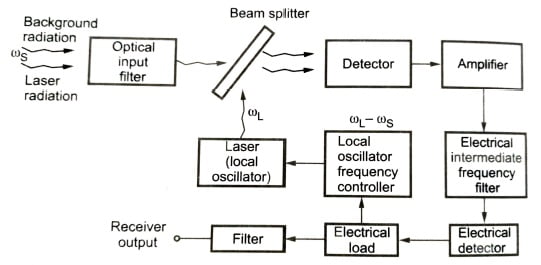The basic difference between Homodyne and Heterodyne Detection is based on the signal carrier and local oscillator frequency. In homodyne detection signal carrier and local oscillator frequency is equal i.e. ωif = 0 and In heterodyne detection signal frequency and carrier frequency are not equal i.e. ωif ≠0.
Table of Contents
Heterodyne Detection
• In heterodyne detection, the local-oscillator frequency (LO) ωLO is chosen to differ from the signal-carrier frequency ω0 such that the intermediate frequency ωIF is in the microwave region (ωIF = 1 GHz). The figure below shows the basic heterodyne detection principle.

- Information can be transmitted through amplitude, phase, or frequency modulation of the optical carrier wave in heterodyne detections.
- Heterodyne detection is used for the construction of Doppler velocimeters and laser rangefinders and as well as in spectroscopy (particular LIDAR systems).
Advantages
- Direct encoding of the spectrum of the incoming signal over a given wavelength range.
- Recording of phase allows for INTERFEROMETERS due to very long baseline interferometry.
- Signals are down-converted to frequencies where low noise electronics can be used.
Applications
The heterodyne detection used in radio as they boost the angular resolution through inter-ferometry.
Homodyne Detection
Optical homodyne detection matches the transmitted signal phases to that of the local oscillator phase signal.
In the homodyne coherent-detection technique, the LO frequency ωLO is selected to coincide with signal-carrier frequency ω0 so that ωIF = 0.

In practice, the construction of such receivers is difficult, because LO must have excellent spectral purity and no power fluctuations. The field of the incoming optical signals is mixed with the local oscillator, whose frequency and phase are locked with that of the signal carrier waves via a PLL. The resultant electrical signal is then filtered. The pulse sequence is then recovered back to the original data by a decision subsystem.
Difference between Homodyne and Heterodyne Detection
| S.No. | Homodyne detection | Heterodyne detection |
| 1 | In homodyne detection signal carrier and local oscillator frequency is equal i.e. ωif = 0. | In heterodyne detection signal frequency and carries frequency are not equal i.e. ωif ≠0. |
| 2 | Highly sensitive. | Sensitivity is degraded by 3 dB. |
| 3 | For making local oscillator frequency equal to signal frequency a PLL is required, which makes circuit complex. | Circuit is easy to implement. |
| 4 | In homodyne detection the baseband (information) signal is directly obtained. | In heterodyne detection a demodulator is required to obtain the information Signal. |
Related Post:
Fibre Optics |Advantages & Application

